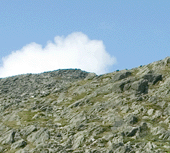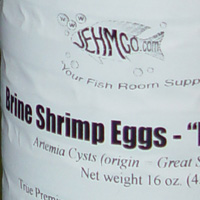

|
Home |
Brine Shrimp CultureIntroduction
Building the HatcheryMaterials:

Step 1: Cut the soda bottle at about 1/3 of its height, measured from the bottom. Make sure the cap is sealed well on the top (test that it will hold water). Invert the top of the bottle and place inside the bottom for support. Step 2: Create a stock solution of salt water from tap water and 1 Tbsp/Liter of your favorite salt mix. You do not need to dechlorinate the tap water. (1 gal = 3.8 Liters) Step 3: Add salt water to within 1" of the top of the hatchery container. Add 1/4 tsp. (or even less) of brine shrimp cysts to the water. Step 4: Attach the flexible airline tube to an air pump on one end, and to the rigid tube on the other end. Put the rigid airline tube through the center of the coarse filter material. Insert the rigid tube into the hatchery, and rubber band the filter material around the top of the hatchery - this will keep salt spray in. Step 5: Turn on air flow, and adjust so that the water and cysts are being vigorously aerated. The amount of flow you want is often likened to a rolling boil. Harvesting the Brine ShrimpWithin 24 hrs or less the brine shrimp cysts will have hatched. Turn off the air pump and place the hatchery container underneath a light. After a few minutes hatched cysts (empty shells) will float on the surface. The brine shrimp will collect in the middle of the bottle and will be drawn towards the light. Any unhatched cysts will settle on the bottom of the container. Draw off brine shrimp from the middle of the container using either a turkey baster, or airline tubing as a siphon. Since brine shrimp are drawn to a light source, you can also use a flashlight to get them all into one area. 
Cut off the bottom of a disposable plastic cup and attach the 50micron filter to the bottom of it with a rubber band. Pour the collected brine shrimp through this cup - you do not want to add the brine shrimp water to your tank. Then rinse them back off in the other direction with tank water. For this purpose, you can also purchase a brine shrimp net online or at an LFS for about $2. Now you are ready to feed! That's all there is to it. You should feed all your nauplii within the first twelve hours of them hatching. After this time, they have used up the yolk sack that they hatched with and their nutritional value is greatly diminished. Brine shrimp feed by absorbing nutrients from the water, so you can feed (enrich) them by adding green water, DT's phytoplankton, selcon, etc. to the hatchery container. Using this technique you can prolong the amount of time you have to use them by about 24-36 hrs. If you wish to maintain them (in a nutritious state) any longer than this, you should read more about their adult culture in the references. Additional CommentsMany sources recommend maintaining the culture at specific temperatures and under lights to improve hatch times and rates. I have found with these cysts that keeping them at room temperature and without any extra lighting (I keep them in the corner of a dimly lit room) I have excellent hatch rates and a hatch time of ~18-20 hrs. If you are feeding the brine shrimp to a reef tank, do not be concerned with getting some cysts in the tank. This is merely an aesthetic problem, as the cysts may collect at the water line and be unsightly. If you are feeding fry, however, you must be very cautious as some small fry may choke on the cysts. If this is a concern for you, read about decapsulating cysts in the references. If you enjoy this project and would like to purchase more cysts, I highly recommend ordering them from Jehm Co., a fish room supply company located in NJ. References
|
